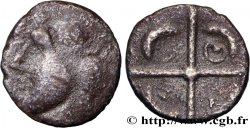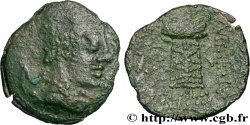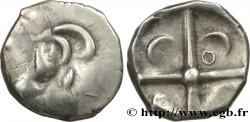v29_0680 - GALLIA - SUDOVESTE DELLA GALLIA LONGOSTALETES (Regione di Narbonne) Drachme “au style languedocien”, S. 335
MONNAIES 29 (2007)
Prezzo di inizio : 320.00 €
Valutazione : 450.00 €
lotto invenduto
Prezzo di inizio : 320.00 €
Valutazione : 450.00 €
lotto invenduto
Tipo : Drachme “au style languedocien”, S. 335
Data: IIe siècle av. J.-C
Metallo : argento
Diametro : 14,7 mm
Peso : 3,49 g.
Grado di rarità : R3
Commenti sullo stato di conservazione:
Monnaie homogène, frappée sur un flan un peu allongé et suffisamment large pour avoir l'ensemble des types de droit et de revers. Patine grise
Pedigree :
Cette monnaie provient de la collection de G. Savès
Diritto
Titolatura diritto : ANÉPIGRAPHE.
Descrittivo diritto : Tête à gauche avec la chevelure à grosses mèches et tresses descendantes à plusieurs brins attachés en bas ; sourcil épais ; cou orné d'un collier de perles ; deux dauphins stylisés devant la bouche.
Rovescio
Titolatura rovescio : ANÉPIGRAPHE.
Descrittivo rovescio : Croix bouletée au centre, formée de quatre cantons, chacun ornés d'une lunule.
Commento
Selon G. Savès, ce type est à rapprocher du type "cubiste" romanisé par son droit. N'est-ce pas plutôt le prototype, encore classique, des monnaies du type "cubiste"? En revanche, les dauphins sont particulièrement stylisés. Dans Moneta 28, cette monnaie est classée en "Rhoda 3e groupe" et datée de la fin du troisième siècle avant J.-C. Les auteurs donnent d'ailleurs un poids de 3,75 grammes pour étayer leur datation, alors même que le poids moyen (des 25 exemplaires dont le poids est indiqué) est de 3,44 grammes, avec un écart allant de 2,46 à 4,41 grammes. Si certaines de ces monnaies datent effectivement de la fin du troisième siècle, l'assimilation excessive à partir des revers seuls peut devenir grotesque.
According to G. Savès, this type is similar to the Romanized \\\"Cubist\\\" type by its right. Is it not rather the prototype, still classical, of the \\\"Cubist\\\" type coins? On the other hand, the dolphins are particularly stylized. In Moneta 28, this coin is classified in \\\"Rhoda 3rd group\\\" and dated to the end of the third century BC. The authors also give a weight of 3.75 grams to support their dating, even though the average weight (of the 25 examples whose weight is indicated) is 3.44 grams, with a range from 2.46 to 4.41 grams. If some of these coins do indeed date from the end of the third century, excessive assimilation based on the reverses alone can become grotesque.
According to G. Savès, this type is similar to the Romanized \\\"Cubist\\\" type by its right. Is it not rather the prototype, still classical, of the \\\"Cubist\\\" type coins? On the other hand, the dolphins are particularly stylized. In Moneta 28, this coin is classified in \\\"Rhoda 3rd group\\\" and dated to the end of the third century BC. The authors also give a weight of 3.75 grams to support their dating, even though the average weight (of the 25 examples whose weight is indicated) is 3.44 grams, with a range from 2.46 to 4.41 grams. If some of these coins do indeed date from the end of the third century, excessive assimilation based on the reverses alone can become grotesque.








 Segnalare un errore
Segnalare un errore Stampate la pagina
Stampate la pagina Condividi mia selezione
Condividi mia selezione Fai una domanda
Fai una domanda Consegnare / vendere
Consegnare / vendere
 Descrittivo
Descrittivo










